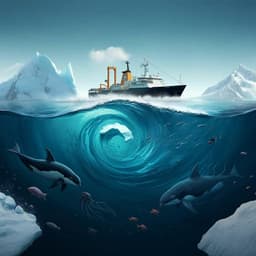
Environmental Studies and Forestry
Severe 21st-century ocean acidification in Antarctic Marine Protected Areas
C. Nissen, N. S. Lovenduski, et al.
Explore the chilling reality of Antarctic coastal waters, where researchers led by Cara Nissen and her team project alarming declines in ocean pH levels due to climate change. This study reveals the dire consequences of ocean acidification and highlights the urgent need for stronger emissions control and expanded Marine Protected Areas to safeguard vulnerable ecosystems.
Playback language: English
Introduction
Ocean acidification (OA), driven by the absorption of anthropogenic carbon dioxide (CO2) into the ocean, poses a significant threat to marine biodiversity globally. The Southern Ocean is particularly vulnerable due to its cold waters, high CO2 concentrations, upwelling of carbon-rich deep waters, and a high Revelle factor. Existing models have struggled to accurately project OA on Antarctic continental shelves due to limitations in resolution and representation of complex processes, particularly within ice-shelf cavities. Observations and regional models indicate that Antarctic shelf waters currently act as a net sink for anthropogenic carbon, primarily due to biologically driven uptake during summer and the prevention of outgassing during winter sea ice cover. However, rising atmospheric CO2, reductions in sea ice cover, and increased freshwater input are expected to exacerbate OA on these shelves. The Commission for the Conservation of Antarctic Marine Living Resources (CCAMLR) is developing a network of MPAs to protect the unique biodiversity of the Southern Ocean. Several MPAs are already established, and several more are proposed. This comprehensive network would protect approximately 60% of Antarctic shelf waters. These MPAs aim to safeguard key organisms, ranging from primary producers (diatoms, *Phaeocystis*) to mid-trophic levels (Antarctic krill, foraminifera, pteropods, small fish), and upper trophic level predators (Antarctic toothfish, seabirds, seals, whales, penguins), as well as the highly diverse benthic ecosystem. OA is only one of several climate change stressors affecting Southern Ocean ecosystems; others include warming, deoxygenation, and changes in sea ice cover and circulation. Studies indicate negative impacts of OA on various organisms, varying in severity across species and life stages. The effects include reduced phytoplankton productivity, decreased krill recruitment, and calcium carbonate shell dissolution. Understanding the cumulative effects of OA, warming, deoxygenation and changes in sea-ice coverage are critical to evaluating and managing the health of the Antarctic ecosystem.
Literature Review
A substantial body of research highlights the global threat of ocean acidification to marine ecosystems (Doney et al., 2009; Orr et al., 2005). The Southern Ocean's sensitivity to OA is well-documented due to its unique oceanographic features (McNeil & Matear, 2008; Hauri et al., 2016; Negrete-García et al., 2019). Previous studies, using coarser resolution models, have had limited success in projecting OA in Antarctic shelf waters (Arrigo et al., 2008; Tagliabue & Arrigo, 2016). However, a growing number of observations (Anderson et al., 1991; Chen, 1994; Hoppema et al., 1998; McNeil et al., 2001; Lo Monaco et al., 2005; Sandrini et al., 2007; Hauck et al., 2010; van Heuven et al., 2011; Huhn et al., 2013; van Heuven et al., 2014; Shadwick et al., 2014; Roden et al., 2016; Mahieu et al., 2020; Ingrosso et al., 2022) and regional modeling efforts (Arrigo et al., 2008; Tagliabue & Arrigo, 2016) provide insights into the current state and potential future trajectories of Antarctic shelf OA. The impacts of OA on Antarctic marine organisms have been extensively studied (Hancock et al., 2020; Figuerola et al., 2021), revealing varying sensitivities across species and life stages, with significant implications for Antarctic food webs (Kawaguchi et al., 2013; Ericson et al., 2018; Kurihara, 2008; Manno et al., 2007; Bednaršek et al., 2012; Hoshijima et al., 2017; Manno et al., 2016; Flynn et al., 2015; Davis et al., 2018; Todgham & Mandic, 2020; Bylenga et al., 2017; Ingels et al., 2012). The establishment and planned expansion of MPAs in the Southern Ocean (Brooks et al., 2020; Trathan & Grant, 2020; Teschke et al., 2021) are crucial conservation efforts, but their effectiveness in mitigating climate change impacts, such as OA, remains to be fully understood.
Methodology
This study employs a high-resolution global ocean-sea ice-biogeochemistry model, FESOM-REcoM, with eddy-permitting resolution on Antarctic continental shelves and a representation of ice-shelf cavities. The model incorporates realistic ice-shelf geometry and resolves the biogeochemical cycles of carbon, nitrogen, silicon, iron, and oxygen. Four Shared Socioeconomic Pathways (SSPs) emission scenarios (SSP1-2.6, SSP2-4.5, SSP3-7.0, SSP5-8.5) were used to force the model from 1950-2100. These scenarios reflect different societal development pathways ranging from sustainability-focused to fossil-fuel-intensive. Model output included 3-hourly atmospheric data from the AWI Climate Model (AWI-CM). The model is initialized with data from AWI-CM (physical tracers of FESOM) and RECCAP2 (biogeochemical tracers of REcoM2). The model was run for several scenarios, including a historical simulation from 1950-2014 and future simulations (2015-2100) based on the four SSPs. Anthropogenic carbon (Cant) concentrations were determined by comparing the full DIC simulations with simulations where atmospheric CO2 was held constant at 1950 levels, isolating the anthropogenic component. Monthly mean pH and the saturation states of aragonite (Qarag) and calcite (Qcalc) were calculated offline using the Python routines mocsy v2.0, utilizing monthly model outputs of relevant parameters. Five existing or proposed Antarctic MPAs were examined: Ross Sea, South Orkney Islands, Weddell Sea, East Antarctic, and Antarctic Peninsula. The MPAs were geographically masked from the larger model outputs, allowing for detailed analysis within these regions. Analysis of model drift was conducted using a control simulation that held both climate variability and CO2 concentrations constant. Finally, two additional simulations were run with constant climate conditions but variable CO2 to evaluate the climate change feedback on OA independently of increasing atmospheric CO2. This allows the researchers to analyze the effect of climate change alone (e.g., changes in temperature, salinity, wind, sea ice) on pH, independently of the direct effect of increasing CO2.
Key Findings
The study's key findings reveal a dramatic intensification of OA in Antarctic MPAs by 2100, particularly under high emission scenarios. The model projects significant declines in pH (up to 0.36 units on the total scale) in the upper 200 meters of the water column across all MPAs. The effect is particularly pronounced on continental shelves, where vigorous vertical mixing of anthropogenic carbon leads to severe OA extending throughout the water column. Under the three highest emission scenarios (SSP2-4.5, SSP3-7.0, SSP5-8.5), aragonite undersaturation (Ωarag < 1) becomes nearly ubiquitous in the waters within the MPAs by 2100. Even under the lowest emission scenario (SSP1-2.6), substantial undersaturation is projected, although the extent is less severe. The study shows that the impact of OA is more severe on continental shelves than in the open ocean, under high emission scenarios. This is attributed to enhanced vertical mixing associated with dense-water formation on these shelves, efficiently transporting anthropogenic carbon from the surface to depth. The onset of aragonite undersaturation varies depending on depth, season, and emission scenario, generally occurring earlier in winter. Under high-emission scenarios, the surface waters in all MPAs become undersaturated with respect to aragonite before 2100. Under the highest emission scenario, the rate of transition from aragonite saturation to undersaturation occurs over several decades, providing a limited window of time for adaptation. However, lower emission scenarios significantly delay and reduce the severity of undersaturation, giving ecosystems more time for potential adaptation. Climate change feedbacks further accelerate OA on continental shelves under high emission scenarios, whereas the climate feedback on OA can be smaller or even opposite in sign under intermediate or low emission scenarios. The relative contribution of the climate feedback to total change in pH ranges from 16 to 20% in the Weddell Sea and Ross Sea MPAs. The increased freshwater input from ice-shelf basal melt combined with the accelerated sea-ice retreat leads to accelerated oceanic CO2 uptake, independent of the increase in atmospheric CO2 levels.
Discussion
These findings have significant implications for the management and conservation of Antarctic MPAs. The projected severity of OA, particularly under intermediate and high emission scenarios, highlights the vulnerability of these ecosystems. While the Weddell Sea has been considered a potential climate change refuge, the study shows that even this region will experience severe OA by 2100 under high emission scenarios. The ubiquitous undersaturation of aragonite under high emission scenarios will likely have profound consequences for aragonite-forming organisms, impacting multiple trophic levels. While the understanding of adaptation and acclimation to OA remains incomplete, the high sensitivity of benthic organisms, combined with other climate-related stressors such as warming, oxygen decline, and sea-ice retreat, makes them particularly vulnerable. This cumulative impact on Antarctic food webs is cause for concern, requiring urgent attention to mitigation efforts.
Conclusion
This study provides compelling evidence of the severe threat of OA to Antarctic MPAs under high emission scenarios. The findings emphasize the critical need for strong emission reductions to protect these unique and vulnerable ecosystems. The study also underscores the importance of integrating climate change impacts into MPA management strategies, promoting adaptive management approaches and potentially considering expanded protection measures. Future research should focus on integrating OA with other stressors and further investigate species-specific sensitivities and adaptation mechanisms to fully understand the potential impact on the Antarctic ecosystem.
Limitations
The study's conclusions are based on model projections, which inherently involve uncertainties associated with climate model projections and parameterizations of complex biogeochemical processes. The model resolution, while high compared to previous studies, may still not fully capture all relevant small-scale processes. Species-specific responses and adaptation potential remain areas of active research, posing challenges to making definitive statements on the impacts of OA across all Antarctic organisms. Further research is needed to quantify the uncertainties associated with the model simulations and to assess the combined effect of OA with other climate change impacts.
Related Publications
Explore these studies to deepen your understanding of the subject.







